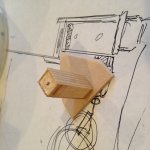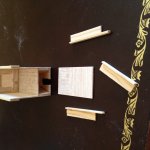Archimedian
Member
This plane was the second balsa airframe to carry the electronics from the FT Tiny Trainer. The goal was a comparable flight regime with landing capability.


Fuse is box construction. The angled air scoop is of low efficiency, but adds structural rigidity for the castoring nosewheel which will run upward through the airstream.

The nosewheel carrier is a long cube of pine, drilled across the grain to take advantage of high density layers in the wood. Thin pine sheeting was epoxied on the four surfaces to prevent breaking the sensitive cube. The threngthened cube is inserted through a sheet of basswood and balsa fillets finish the surface.

A long strip of pine reinforces the top edges. Holes are predrilled and allow for an adjustable wing position. They are the primary structural element of the fuse.

Pine noseframe ties the pine runners into the frontal nose panels. The pod area is sheeted on top.

Completed nose assembly.

Ribs are cut by clamping between two rib forms.

Tapered wing. Zero sweep allows for a straight spar. The top surface is level, while the bottom surface tapers toward the tip. Chord tapers toward the tip.

I did not make a complete D-tube wing sheet, and the wing twisted easily. For this reason i added geodesic ribs. These ribs do not contact the final tissue.

I decided to maximize the leftover spar tips by tapering them agressively at the tip, then sheeting them with a curved top and a flat bottom. Top sheet first, then sand along the bottom spar tip to achieve planform on the top sheet. Cut bottom sheet to fit. No good pics of this.

Each tail surface is made of two sheets of delaminated foam board that have been sandwiched and sanded. This was glued on lightly as a safe failure point. Despite a small and moderate distance elevator, authority is more than sufficient.
All up, 200-250 grams. 36" wingspan. Handles easily well into stall region. It handles gracefully but requires constant attention when it comes to roll.
Videos to come demonstrating the nose spring, ailerons, and flight.
Oh, and the wheels were made of foamboard with a thin balsa tread. a sturdy hub was made by slapping epoxy/filler composite around a paper tube rolled around the axle. No pics of this either but i plan to make a thread on these incredibly simple, light, thin, but wide-hubbed wheels.
Feel free to post pics your own builds offering techniques or similar elements.


Fuse is box construction. The angled air scoop is of low efficiency, but adds structural rigidity for the castoring nosewheel which will run upward through the airstream.

The nosewheel carrier is a long cube of pine, drilled across the grain to take advantage of high density layers in the wood. Thin pine sheeting was epoxied on the four surfaces to prevent breaking the sensitive cube. The threngthened cube is inserted through a sheet of basswood and balsa fillets finish the surface.

A long strip of pine reinforces the top edges. Holes are predrilled and allow for an adjustable wing position. They are the primary structural element of the fuse.

Pine noseframe ties the pine runners into the frontal nose panels. The pod area is sheeted on top.

Completed nose assembly.

Ribs are cut by clamping between two rib forms.

Tapered wing. Zero sweep allows for a straight spar. The top surface is level, while the bottom surface tapers toward the tip. Chord tapers toward the tip.

I did not make a complete D-tube wing sheet, and the wing twisted easily. For this reason i added geodesic ribs. These ribs do not contact the final tissue.

I decided to maximize the leftover spar tips by tapering them agressively at the tip, then sheeting them with a curved top and a flat bottom. Top sheet first, then sand along the bottom spar tip to achieve planform on the top sheet. Cut bottom sheet to fit. No good pics of this.

Each tail surface is made of two sheets of delaminated foam board that have been sandwiched and sanded. This was glued on lightly as a safe failure point. Despite a small and moderate distance elevator, authority is more than sufficient.
All up, 200-250 grams. 36" wingspan. Handles easily well into stall region. It handles gracefully but requires constant attention when it comes to roll.
Videos to come demonstrating the nose spring, ailerons, and flight.
Oh, and the wheels were made of foamboard with a thin balsa tread. a sturdy hub was made by slapping epoxy/filler composite around a paper tube rolled around the axle. No pics of this either but i plan to make a thread on these incredibly simple, light, thin, but wide-hubbed wheels.
Feel free to post pics your own builds offering techniques or similar elements.
